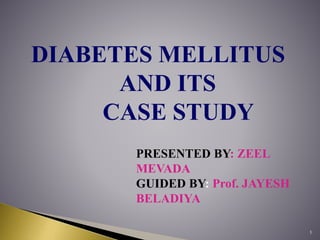diabetes case study
- 1. DIABETES MELLITUS AND ITS CASE STUDY PRESENTED BY: ZEEL MEVADA GUIDED BY: Prof. JAYESH BELADIYA 1
- 2. ï Introduction of DM type 1 ï Epidemiology ï Pathophysiology ï Clinical manifestation ï Diagnosis ï Treatments ï Case study 2
- 3. ï The disease is characterized by an absolute deficiency of insulin caused by an autoimmune attack on the Îē cells of the pancreas. ï About 10% of the ten million diabetics in USA has type 1 diabetes, only (2/3)is diagnosed. ï Complication: stroke, heart attack, kidney disease, eye disease and nerve damage. 3
- 4. ï Progressive destruction of pancreatic cells Auto antibodies cause a reduction of 80% to 90% of normal cell function before manifestations occur 4
- 5. 5
- 6. Viral infection Alteration of self cells Auto immune response Destruction of beta cells Insulin deficiency Type1 diabetes mellitus 6
- 7. -Genetic predisposition -Exposure to virus 7
- 8. 8
- 9. Weight loss Polydipsia (excessive thirst) Polyuria(frequent urination) Polyphagia(excessive hunger) Weakness and fatigue Ketoacidosis 9
- 10. Random blood sugar test :primary screening test for type 1 diabetes. A blood sample is taken at a random time. random blood sugar level of 200 milligrams per deciliter (mg/dL), or 11.1 millimoles per liter (mmol/L), or higher suggests diabetes. 10
- 11. Glycated hemoglobin (A1C) test: This test indicates your child's average blood sugar level for the past two to three months. Specifically, the test measures the percentage of blood sugar. attached to the oxygen- carrying protein in red blood cells (hemoglobin). An A1C level of 6.5 percent or higher on two separate tests indicates diabetes 11
- 12. ï Blood tests to check for antibodies that are common in type 1 diabetes ï Urine tests to check for the presence of ketones, which also suggests type 1 diabetes rather than type 2 12
- 13. Exogenous insulin: â Required for all patient with type 1 DM. Types of insulin â Human insulin âĒ Most widely used type of insulin âĒ Cost-effective âĒ Likelihood of allergic reaction 13
- 14. Patients name : DP Age: 7 year Sex: Female Weight: 22kg Presenting symptoms: ï Cold& fever ï Recument stomach ï Nausea vomiting ï Lost weight ï Drinking large quantity of water& juices ï Wetting bed 14
- 15. Random blood sugar level :14mMol/L(3.5- 10mMol/L) ï Negative for ketone ï Diagnosis of Mild ketosis was made presenting secondary to newly diagnosed type 1 diabetes 15
- 16. ï Nausea vomiting ï Lost weight ï Drinking large quantity of water& juices ï Wetting bed 16
- 17. Mechanism 17
- 18. 18
- 19. Resembles to type 1 DM, negative for ketones (lab data) Misdiagnosed because patients have mild ketosis 19
- 20. ï To reduce blood glucose to normal level ï To reduce any other risk factors which may be life threatening ï Provide healthy diet 20
- 21. Can be advised with: ï Eat regularly ,choose high fiber food which have low glycemic index. ï Use less butter cheese eat fewer fatty meals ï Choose yoghurt skimmed milk , steam or baked meals To monitor regimen: ï Use alternate site for the injection ï Check blood glucose level every month 21
- 22. ï Inject insulin subcutaneously on alternate site 22
- 23. 23






















